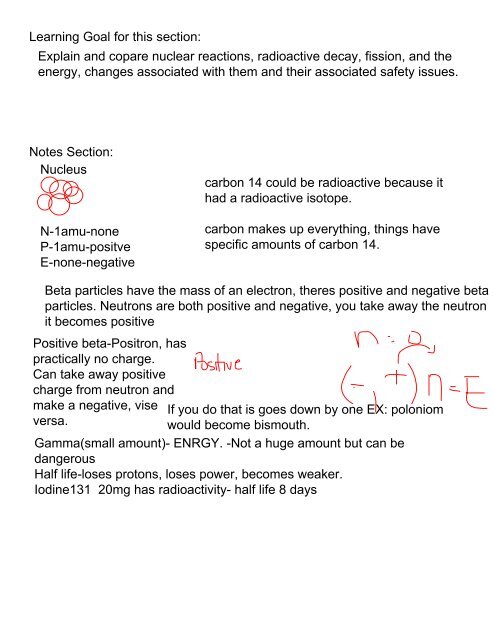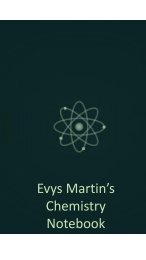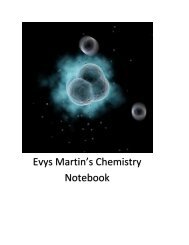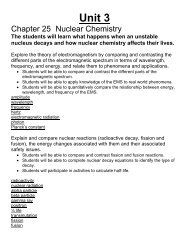Semester 1 Notebook-Martin
Create successful ePaper yourself
Turn your PDF publications into a flip-book with our unique Google optimized e-Paper software.
The Nucleus<br />
A typical model of the atom is called the Bohr Model, in<br />
honor of Niels Bohr who proposed the structure in 1913. The Bohr atom consists of a central nucleus<br />
composed of neutrons and protons, which is surrounded by electrons which “orbit” around the nucleus.<br />
Protons carry a positive charge of one and have a mass of about 1 atomic mass unit or amu (1 amu =1.7x10-<br />
27 kg, a very, very small number). Neutrons are electrically “neutral” and also have a mass of about 1 amu. In<br />
contrast electron carry a negative charge and have mass of only 0.00055 amu. The number of protons in a<br />
nucleus determines the element of the atom. For example, the number of protons in uranium is 92 and the<br />
number in neon is 10. The proton number is often referred to as Z.<br />
Atoms with different numbers of protons are called elements, and are arranged in the periodic table with<br />
increasing Z.<br />
Atoms in nature are electrically neutral so the number of electrons orbiting the nucleus equals the number of<br />
protons in the nucleus.<br />
Neutrons make up the remaining mass of the nucleus and provide a means to “glue” the protons in place.<br />
Without neutrons, the nucleus would split apart because the positive protons would repel each other. Elements<br />
can have nucleii with different numbers of neutrons in them. For example hydrogen, which normally only has<br />
one proton in the nucleus, can have a neutron added to its nucleus to from deuterium, ir have two neutrons<br />
added to create tritium, which is radioactive. Atoms of the same element which vary in neutron number are<br />
called isotopes. Some elements have many stable isotopes (tin has 10) while others have only one or two. We<br />
express isotopes with the nomenclature Neon-20 or 20 Ne 10, with twenty representing the total number of<br />
neutrons and protons in the atom, often referred to as A, and 10 representing the number of protons (Z).<br />
Alpha Particle<br />
Decay<br />
Alpha decay is a radioactive process in which a<br />
particle with two neutrons and two protons is<br />
ejected from the nucleus of a radioactive atom. The particle is identical to the nucleus of a helium atom.<br />
Alpha decay only occurs in very heavy elements such as uranium, thorium and radium. The nuclei of these<br />
atoms are very “neutron rich” (i.e. have a lot more neutrons in their nucleus than they do protons) which makes<br />
emission of the alpha particle possible.<br />
After an atom ejects an alpha particle, a new parent atom is formed which has two less neutrons and two less<br />
protons. Thus, when uranium-238 (which has a Z of 92) decays by alpha emission, thorium-234 is created<br />
(which has a Z of 90).<br />
Because alpha particles contain two protons, they have a positive charge of two. Further, alpha particles are<br />
very heavy and very energetic compared to other common types of radiation. These characteristics allow alpha<br />
particles to interact readily with materials they encounter, including air, causing many ionizations in a very short<br />
distance. Typical alpha particles will travel no more than a few centimeters in air and are stopped by a sheet of<br />
paper.








